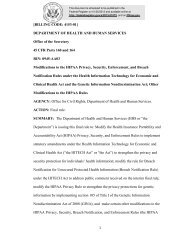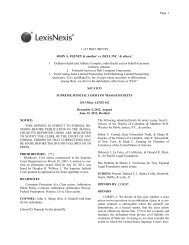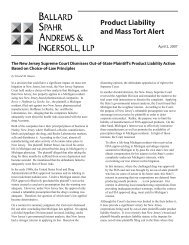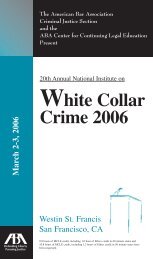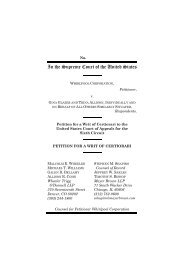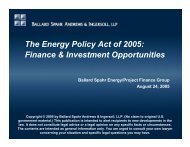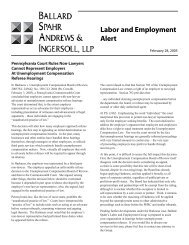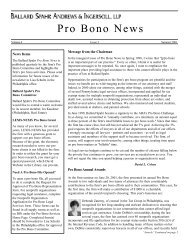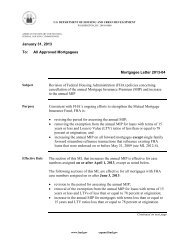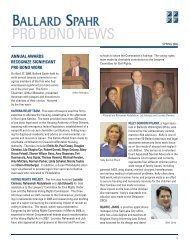Dispute Resolution - Ballard Spahr LLP
Dispute Resolution - Ballard Spahr LLP
Dispute Resolution - Ballard Spahr LLP
Create successful ePaper yourself
Turn your PDF publications into a flip-book with our unique Google optimized e-Paper software.
®<br />
<strong>Dispute</strong> <strong>Resolution</strong><br />
in 48 jurisdictions worldwide<br />
2010<br />
Contributing editor: Simon Bushell<br />
Published by<br />
Getting the Deal Through<br />
in association with:<br />
Advokaturbüro Dr Dr Batliner & Dr Gasser<br />
Alves Pereira, Teixeira de Sousa & Associados<br />
Anderson Mōri & Tomotsune<br />
Araújo e Policastro Advogados<br />
Attorneys-at-law Juridia Ltd<br />
Bharucha & Partners<br />
Bianchi Rubino-Sammartano & Associati<br />
Bredin Prat<br />
Charles Adams Ritchie & Duckworth<br />
Condon & Forsyth <strong>LLP</strong><br />
Conway & Partners<br />
Dacheng Law Offices<br />
ELIG<br />
Frank Advokatbyrå AB<br />
Fulbright & Jaworski <strong>LLP</strong><br />
Geoffrey Dunne & Co Solicitors<br />
GSK Stockmann + Kollegen<br />
Habib Al Mulla & Co<br />
Herbert Smith <strong>LLP</strong><br />
Hoet Peláez Castillo & Duque Abogados<br />
Hogan Lovells<br />
Isolas<br />
Jenner & Block <strong>LLP</strong><br />
Kelemenis & Co<br />
Kleyr Grasso Associés<br />
Law Firm Yust <strong>LLP</strong><br />
Liedekerke Wolters Waelbroeck Kirkpatrick<br />
Magisters<br />
Miller, Canfield, Paddock and Stone, PLC<br />
Monereo Meyer Marinel-lo Abogados<br />
Niederer Kraft & Frey<br />
Nordia Law Firm<br />
Odvetniki Šelih & partnerji, op, dno<br />
Preti, Flaherty, Beliveau & Pachios <strong>LLP</strong><br />
Richards, Layton & Finger, PA<br />
Schönherr<br />
Shin & Kim<br />
Sofunde, Osakwe, Ogundipe & Belgore<br />
Stillman, Friedman & Shechtman, PC<br />
Sudath Perera Associates<br />
Tilleke & Gibbins<br />
Varul Vilgerts Smaliukas<br />
Wardyński & Partners<br />
Werksmans<br />
Wiesner & Asociados Ltda Abogados<br />
Woods <strong>LLP</strong><br />
r gaThe international journal of<br />
commercial and treaty arbitration
contents<br />
®<br />
<strong>Dispute</strong><br />
<strong>Resolution</strong> 2010<br />
Contributing editor:<br />
Simon Bushell<br />
Herbert Smith <strong>LLP</strong><br />
Business development manager<br />
Joseph Samuel<br />
Marketing managers<br />
Alan Lee<br />
George Ingledew<br />
Robyn Hetherington<br />
Dan White<br />
Tamzin Mahmoud<br />
Ellie Notley<br />
Subscriptions manager<br />
Nadine Radcliffe<br />
Subscriptions@<br />
GettingTheDealThrough.com<br />
Assistant editor<br />
Adam Myers<br />
Editorial assistant<br />
Nina Nowak<br />
Senior production editor<br />
Jonathan Cowie<br />
Chief subeditor<br />
Jonathan Allen<br />
Senior subeditor<br />
Kathryn Smuland<br />
Subeditors<br />
Ariana Frampton<br />
Sara Davies<br />
Charlotte Stretch<br />
Editor-in-chief<br />
Callum Campbell<br />
Publisher<br />
Richard Davey<br />
<strong>Dispute</strong> <strong>Resolution</strong> 2010<br />
Published by<br />
Law Business Research Ltd<br />
87 Lancaster Road<br />
London, W11 1QQ, UK<br />
Tel: +44 20 7908 1188<br />
Fax: +44 20 7229 6910<br />
© Law Business Research Ltd<br />
2010<br />
No photocopying: copyright<br />
licences do not apply.<br />
ISSN 1741-0630<br />
The information provided in this<br />
publication is general and may not<br />
apply in a specific situation. Legal<br />
advice should always be sought before<br />
taking any legal action based on the<br />
information provided. This information<br />
is not intended to create, nor does<br />
receipt of it constitute, a lawyer–client<br />
relationship. No legal advice is<br />
being given in the publication. The<br />
publishers and authors accept<br />
no responsibility for any acts or<br />
omissions contained herein. Although<br />
the information provided is accurate<br />
as of July 2010, be advised that this<br />
is a developing area.<br />
Printed and distributed by<br />
Encompass Print Solutions<br />
Tel: 0870 897 3239<br />
Law<br />
Business<br />
Research<br />
Introduction Simon Bushell Herbert Smith <strong>LLP</strong> 3<br />
Austria Gerold Zeiler and Wolfgang Höller Schönherr 5<br />
Belgium Joe Sepulchre, Hakim Boularbah and Charlotte Marquet Liedekerke Wolters Waelbroeck Kirkpatrick 13<br />
Brazil Sylvio Paes de Barros Jr and Alexandre Lins Morato Araújo e Policastro Advogados 23<br />
Canada – Quebec James A Woods, Christopher L Richter and Marie Louise Delisle Woods <strong>LLP</strong> 28<br />
Cayman Islands Graham F Ritchie QC and David W Collier Charles Adams Ritchie & Duckworth 33<br />
China Dennis Deng Dacheng Law Offices 39<br />
Colombia Dario Cadena Lleras and Eduardo A Wiesner Wiesner & Asociados Ltda Abogados 44<br />
Denmark Niels Schiersing Nordia Law Firm 50<br />
England & Wales Simon Bushell Herbert Smith <strong>LLP</strong> 57<br />
Estonia Paul Varul, Lauri Almann and Ramon Rask Varul Vilgerts Smaliukas 64<br />
Finland Pekka Inkeroinen and Martina Kronström Attorneys-at-law Juridia Ltd 70<br />
France Tim Portwood Bredin Prat 75<br />
Germany Karl von Hase GSK Stockmann + Kollegen 83<br />
Gibraltar Kerrin Drago, Jonathan Garcia, Samantha Grimes and Jamie Trinidad Isolas 89<br />
Greece Athanassia Papantoniou and Yannis Kelemenis Kelemenis & Co 94<br />
India Vivek A Vashi and Sushma Nagaraj Bharucha & Partners 101<br />
Ireland Geoffrey Dunne Geoffrey Dunne & Co Solicitors 108<br />
Italy Mauro Rubino-Sammartano and Robert Rudek Bianchi Rubino-Sammartano & Associati 115<br />
Japan Naoki Iguchi and Taisuke Yamamoto Anderson Mōri & Tomotsune 122<br />
Korea Benjamin Hughes, Beomsu Kim and Seungmin Lee Shin & Kim 127<br />
Latvia Debora Pavila and Vairis Dmitrijevs Varul Vilgerts Smaliukas 132<br />
Liechtenstein Johannes Gasser Advokaturbüro Dr Dr Batliner & Dr Gasser 137<br />
Lithuania Inga Martinkutė, Giedrė Gailiūtė, Lina Jonikaitė Varul Vilgerts Smaliukas 143<br />
Luxembourg Marc Kleyr Kleyr Grasso Associés 149<br />
Netherlands Nathan O’Malley and Thabiso van den Bosch Conway & Partners 156<br />
Nigeria Babajide Oladipo Ogundipe and Lateef Omoyemi Akangbe Sofunde, Osakwe, Ogundipe & Belgore 162<br />
Poland Monika Hartung and Katarzyna Petruczenko Wardyński & Partners 167<br />
Portugal José Alves Pereira and João Marques de Almeida Alves Pereira, Teixeira de Sousa & Associados 173<br />
Russia Alexander Bolomatov and Lebedeva Elena Law Firm Yust <strong>LLP</strong> 179<br />
Slovenia Gregor Simoniti and Tilen Terlep Odvetniki Šelih & partnerji, op, dno 185<br />
South Africa Des Williams Werksmans 194<br />
Spain César García de Quevedo and Eva M Vázquez Monereo Meyer Marinel-lo Abogados 200<br />
Sri Lanka Sudath Perera, Manoj Bandara, Ali Tyebkhan and Dilushi Wickremesinghe<br />
Sudath Perera Associates 205<br />
Sweden Marcus Axelryd and Helena Dandenell Frank Advokatbyrå AB 211<br />
Switzerland Ernst F Schmid Niederer Kraft & Frey 216<br />
Thailand Sally Mouhim and Thawat Damsa-ard Tilleke & Gibbins 222<br />
Turkey Serkan İçtem ELIG 228<br />
Ukraine Serhii Sviriba, Dmytro Marchukov and Olga Glukhovska Magisters 234<br />
United Arab Emirates Habib Al Mulla, Karim Nassif and Gordon Blanke Habib Al Mulla & Co 240<br />
United States – California Roderick D Margo, Scott D Cunningham and Stephen M Rinka<br />
Condon & Forsyth <strong>LLP</strong> 247<br />
United States – Delaware Samuel A Nolen, Robert M Whetzel and Chad M Shandler<br />
Richards, Layton & Finger, PA 253<br />
United States – Florida Daniel E González and Parker Thomson Hogan Lovells 259<br />
United States – Illinois Lawrence S Schaner Jenner & Block <strong>LLP</strong> 265<br />
United States – Maine Gregory P Hansel Preti, Flaherty, Beliveau & Pachios <strong>LLP</strong> 271<br />
United States – Michigan Frederick A Acomb and Mary K Griffith Miller, Canfield, Paddock and Stone, PLC 277<br />
United States – New York Marjorie J Peerce and Mary Margulis-Ohnuma<br />
Stillman, Friedman & Shechtman, PC 283<br />
United States – Texas William D Wood, Kevin O’Gorman and Lance R Bremer Fulbright & Jaworski <strong>LLP</strong> 291<br />
Venezuela Carlos Domínguez Hernández and Diego Thomás Castagnino<br />
Hoet Peláez Castillo & Duque Abogados 299<br />
www.gettingthedealthrough.com
Stillman, Friedman & Shechtman, PC<br />
united states – new york<br />
New York<br />
Marjorie J Peerce and Mary Margulis-Ohnuma<br />
Stillman, Friedman & Shechtman, PC<br />
Litigation<br />
1 Court system<br />
What is the structure of the civil court system<br />
Court of Appeals<br />
The Court of Appeals is the highest court of the state and hears<br />
both criminal and civil appeals. It is comprised of a chief judge and<br />
six associate judges, appointed by the governor for 14-year terms.<br />
Five judges are needed for a quorum, four for a decision. The Court<br />
of Appeals reviews only questions of law, with two exceptions: it<br />
reviews facts on an appeal from a criminal judgment imposing the<br />
death penalty, and on review of an appellate division decision reversing<br />
or modifying a judgment, finding new facts, and directing that a<br />
final judgment be entered on the new facts.<br />
Appellate Division<br />
The appellate division (First, Second, Third and Fourth Departments)<br />
hears appeals from the supreme court, county courts, family court,<br />
surrogate’s court, court of claims and appellate terms of the supreme<br />
court. It reviews both the law and the facts. The justices are members<br />
of the supreme court whom the governor has designated to sit on the<br />
appellate division. Up to five judges sit on a panel, four are needed for<br />
a quorum, three for a decision. It also has original jurisdiction over<br />
cases in which the facts are not in dispute and only a decision on the<br />
law is required, article 78 proceedings against a supreme court justice<br />
and other special proceedings.<br />
Supreme Court<br />
The supreme court has statewide jurisdiction and a branch in each<br />
county. Its justices are elected to the court from judicial districts for<br />
14-year terms. The supreme court is the state’s sole court of ‘general<br />
jurisdiction’, which means it has original jurisdiction over virtually<br />
any case. However, where another court also has original jurisdiction,<br />
that other court handles the matter. Appeals from the supreme<br />
court generally go to the appellate division.<br />
Commercial part of the Supreme Court<br />
A ‘commercial part’ has been established within the supreme court<br />
in some counties to hear business or commercial disputes. There are<br />
monetary thresholds for bringing cases in the commercial part.<br />
Appellate term of the Supreme Court<br />
The appellate term is a lower-level appellate court created by the<br />
appellate division. Up to three supreme court justices sit on a panel,<br />
two are needed for a quorum, two for a decision. In both the First<br />
and Second Departments, the appellate term hears appeals from the<br />
New York City civil and criminal courts, and in the Second Department<br />
it also hears appeals from the district, city, town and village<br />
courts and from the county courts in civil cases and some criminal<br />
cases. Appeals from the appellate term go to the appellate division.<br />
County courts<br />
County courts exist in each county outside New York City. The<br />
judges are elected to 10-year terms. The court hears monetary disputes<br />
up to US$25,000 where at least one defendant resides in or<br />
has a business office in the county and the claim arose in the county<br />
(counterclaims are not subject to the US$25,000 limitation); disputes<br />
relating to real property within the county (no monetary limitation);<br />
actions to recover chattel (value up to US$25,000) in the county,<br />
etc. It also hears incompetency proceedings involving county residents,<br />
and proceedings involving real property within the county<br />
owned by an incompetent person wherever he or she resides. In the<br />
Third and Fourth appellate division departments, the county court<br />
hears appeals from the city, town and village courts. Appeals from<br />
the county court go to the appellate division, except in the Second<br />
Department, where appeals go to the appellate term.<br />
Surrogate’s court<br />
Each county has a surrogate’s court, with at least one judge. In New<br />
York City counties, the surrogate is elected to a 14-year term; in other<br />
counties, it is a 10-year term. The surrogate’s court handles probating<br />
of wills and estates of the deceased. Appeals from the surrogate’s<br />
court go to the appellate division.<br />
Family Court<br />
Each county has a family court, with at least one judge. In New<br />
York City, judges are appointed by the mayor; elsewhere in the state<br />
they are elected. They serve for 10-year terms. The family court has<br />
jurisdiction over matters pertaining to family life, including support,<br />
neglect, paternity, adoption, guardianship, custody and juvenile<br />
delinquency. Adoption is handled by the family court or the surrogate’s<br />
court. Matrimonial actions are handled by the supreme court;<br />
however, it may refer related custody and support issues to the family<br />
court. Appeals from the family court go to the appellate division.<br />
Court of Claims<br />
This court has jurisdiction over claims against the state or by the state<br />
against the claimant. Its judges are appointed by the governor, with<br />
the advice and consent of the senate, for nine-year terms. Appeals<br />
from the court of claims go to the appellate division.<br />
New York City Civil Court<br />
This court hears monetary disputes up to US$25,000; it also has<br />
jurisdiction over interpleader and cross-claims of up to US$25,000.<br />
(Counterclaims are not subject to the US$25,000 limit.) It has jurisdiction<br />
over summary proceedings involving the dispossession of<br />
property and the recovery of rent (recovery of rent is not limited by<br />
the US$25,000 restriction). The small claims ‘court’ is an accelerated<br />
procedure for hearing money cases of up to US$5,000. Judges are<br />
elected to 10-year terms. Appeals from this court go to the appellate<br />
term.<br />
www.gettingthedealthrough.com 283
United states – new york<br />
Stillman, Friedman & Shechtman, PC<br />
District courts<br />
There are two district courts: one in Nassau County and one in western<br />
Suffolk County. The district court has jurisdiction over money<br />
and replevin actions up to US$15,000, including interpleader claims.<br />
(Counterclaims and summary proceedings for rent are not subject to<br />
the US$15,000 restriction.) The small claims part hears claims up<br />
to US$5,000. (Under CPLR (Civil Practice Laws and Rules) 3405,<br />
cases for US$6,000 and under can be sent to compulsory arbitration.)<br />
Judges are elected to six-year terms. Appeals from this court<br />
go to the county court unless an appellate term has been established<br />
to hear these appeals.<br />
City courts<br />
Each of the 61 cities outside New York City has a city court. The<br />
city courts’ civil jurisdiction and practice is similar to that of the<br />
district courts described above. Appeals from this court go to the<br />
county court, unless an appellate term has been established to hear<br />
these appeals.<br />
Town and village courts<br />
Each county outside New York City is divided into towns, and within<br />
these towns are villages. The town and village courts have jurisdiction<br />
over monetary and replevin actions up to US$3,000 (this restriction<br />
also applies to counterclaims). The court also has jurisdiction<br />
over summary proceedings for rent (no monetary limitation). Town<br />
and village justices need not be attorneys. Appeals from this court<br />
go to the county court, unless an appellate term has been established<br />
to hear these appeals.<br />
2 Judges and juries<br />
What is the role of the judge and the jury in civil proceedings<br />
Whether a jury is allowed depends on whether the type of action<br />
evolved through the common law courts (which historically had jury<br />
trials) or the courts of equity (historically non-jury). In a jury trial,<br />
the jury decides questions of fact and the judge decides questions of<br />
law; in a non-jury trial, the judge decides issues of fact and law. Trial<br />
by jury must be demanded in the note of issue filed with the court; if<br />
a party is served with a note of issue that does not contain a demand<br />
for a jury and that party wants a jury trial, that party must file a<br />
demand within 15 days of being served.<br />
CPLR 4101 lists types of civil actions for which jury trials are<br />
permitted:<br />
• money actions, in tort or contract;<br />
• actions for ejectment, dower, waste, abatement of and damages<br />
for nuisance, to recover chattel or to establish certain claims to<br />
real property; and<br />
• ‘any other action in which a party is entitled by the constitution<br />
or by express provision of law to a trial by jury’.<br />
Other statutes authorising trial by jury include the Domestic Relations<br />
Law, which allows juries in divorce and annulment cases, and<br />
the Real Property Actions and Proceedings Law, which allows juries<br />
in summary proceedings to recover real property. In certain cases,<br />
such as worker’s compensation, a statutory provision has eliminated<br />
the right to a jury trial.<br />
3 Limitation issues<br />
What are the time limits for bringing civil claims<br />
Article 2 of the CPLR lists many commonly invoked limitations of<br />
time, including the 20-year period to enforce a money judgment,<br />
the 10-year period for real property claims, the six-year period<br />
for contract claims (except sales contracts subject to UCC section<br />
2-725’s four-year period) and fraud claims (or two years after a<br />
person exercising reasonable diligence would have discovered the<br />
fraud), the three-year period for unintentional tort claims, injury to<br />
property, replevin and malpractice claims against professionals<br />
(except medical, dental, podiatric), the 2.5-year period for medical,<br />
dental or podiatric malpractice claims, and the one-year period for<br />
intentional tort cases, among others.<br />
Other important limitations periods include the five-year period<br />
for divorce or separation (Domestic Relations Law, section 210),<br />
and the two-year period for wrongful death claims (Estates, Powers<br />
and Trusts Law, section 5-4.1), among others. Tort actions against a<br />
municipality must be brought within one year and 90 days, and are<br />
also subject to a 90-day notice of claim period (General Municpal<br />
Law, sections 50-i and 50-e).<br />
Parties can agree to modify the limitations period. Parties to a<br />
contract may provide for a shorter limitations period in the original<br />
contract, as long as such period is reasonable; but for certain sales<br />
contracts it may only be reduced to one year (see UCC section 2-<br />
725(1)). An agreement to lengthen the period in a contract case is<br />
valid if made after the cause of action accrues and is in writing and<br />
signed (see General Obligations Law, section 17-103(1)). There are<br />
no statutory rules for extension agreements in tort and other noncontract<br />
cases.<br />
4 Pre-action behaviour<br />
Are there any pre-action considerations the parties should take into<br />
account<br />
In some cases, a notice of claim must be served within a certain time<br />
after the claim arises which notifies the potential defendant that a<br />
claim may be brought against him. (For example, General Municipal<br />
Law section 50-e (tort claims against public corporations (city,<br />
county, town, village, fire district, school district, etc) and Court of<br />
Claims Act, section 10 (suits against the state)).<br />
CPLR 3102(c) provides for pre-suit disclosure by court order<br />
‘in aid of bringing an action, to preserve information or to aid in<br />
arbitration’.<br />
CPLR 6313 provides for emergency relief in the form of a temporary<br />
restraining order (TRO) where there is a danger of immediate<br />
and irreparable loss or damage unless the defendant is restrained. It<br />
is brought by order to show cause, a type of ex parte application. If<br />
a summons has not already been served, it must be served with the<br />
order to show cause; in such cases, the action is filed at the same time<br />
as, or just prior to, the TRO application.<br />
5 Starting proceedings<br />
How are civil proceedings commenced<br />
A civil action is commenced in the supreme, county, civil, district<br />
and city courts by filing a summons and complaint, summons with<br />
notice or petition with the court clerk, along with payment of any<br />
required fee. The plaintiff has 120 days after filing in which to serve<br />
the defendant; if service is effected within that time frame or within<br />
the period as extended by the court, the action is deemed commenced<br />
as of the filing date. In the town and village courts, service (rather<br />
than filing) of the summons and complaint commences the action.<br />
6 Timetable<br />
What is the typical procedure and timetable for a civil claim<br />
If a summons is served with complaint, the defendant must answer<br />
within 20 days if served by personal delivery to the defendant in New<br />
York or 30 days if served by any other method. Alternatively, the<br />
defendant may move to dismiss the complaint (same time limits) or<br />
to compel its amendment (within 20 days of service). If the summons<br />
is served with notice, the defendant serves a notice of appearance on<br />
the plaintiff’s attorney 20 or 30 days after service, depending on the<br />
method of service, and usually makes a demand for the complaint<br />
at that time.<br />
284 Getting the Deal Through – <strong>Dispute</strong> <strong>Resolution</strong> 2010
Stillman, Friedman & Shechtman, PC<br />
united states – new york<br />
The answer contains the defendant’s admissions or denials (or<br />
both) regarding the allegations in the complaint, and silence regarding<br />
any particular allegation is deemed an admission. The answer<br />
should include any applicable affirmative defences, and defences<br />
not raised in the answer may be deemed waived. The answer may<br />
also include counterclaims (defendant’s claims against plaintiff,<br />
whether or not they are related to the plaintiff’s action) and crossclaims<br />
against co-defendants (whether or not they are related to<br />
the plaintiff’s claim); an answer to a cross-claim is only required if<br />
such answer is demanded in the pleading containing the cross-claim,<br />
and otherwise is deemed denied. An answer to a cross-claim should<br />
be served within 20 days after service of the pleading containing<br />
the cross-claim; where the cross-claim is served on a non-party, the<br />
answer should be served within 20 or 30 days (depending on the<br />
method of service). The plaintiff must respond to any counterclaims<br />
in the defendant’s answer in a reply; failure to reply can result in a<br />
default on the counterclaim. Parties may stipulate extensions of time<br />
to plead or may move the court for an extension.<br />
8 Evidence – documents<br />
Is there a duty to preserve documents and other evidence pending<br />
trial Must parties share relevant documents (including those<br />
unhelpful to their case)<br />
CPLR 3101 sets forth the standard for disclosability in New York<br />
civil practice: ‘Generally … [t]here shall be full disclosure of all matter<br />
material and necessary in the prosecution or defense of an action<br />
[…]’. Except for privileged matter, attorney’s work product, etc, parties<br />
generally must disclose relevant matter upon request.<br />
Parties to litigation as well as others on notice of ongoing or possible<br />
future litigation have a duty to preserve documents and other<br />
evidence pending trial, and CPLR 3126 gives courts broad discretion<br />
to impose sanctions when a party deliberately fails to comply<br />
with a discovery order or destroys evidence prior to the adversary’s<br />
inspection of it. Sanctions for spoliation range from the striking of a<br />
pleading, to preclusion of evidence or testimony, to lesser sanctions<br />
or no sanctions, depending on the circumstances and the resulting<br />
prejudice to the opponent’s case.<br />
7 Case management<br />
Can the parties control the procedure and the timetable<br />
Under Uniform Rule 202.12, any party may request a preliminary<br />
conference after service of process. If a judge has not already been<br />
assigned, the request must be accompanied by a request for judicial<br />
intervention (RJI). The conference is scheduled for a date within<br />
45 days from filing of the RJI. The purpose of the conference is to<br />
simplify the issues, set a timetable for disclosure, add other parties<br />
if necessary, etc. At its conclusion, the judge issues a written order<br />
embodying his or her instructions, including a timetable for disclosure<br />
(generally to be completed within 12 months, or 15 months<br />
for complex cases), or may direct the plaintiff to file the transcript<br />
with the court clerk. If the parties agree on a disclosure schedule in<br />
advance of the conference and submit it by stipulation, the court will<br />
approve the stipulation and cancel the conference.<br />
CPLR article 31 sets forth the disclosure devices. Ordinarily,<br />
disclosure is brought on by stipulation or notice, and parties are<br />
expected to confer and agree on the time and place for depositions,<br />
etc. Because the plaintiff may not notice a party’s deposition before<br />
that party’s time for serving a responsive pleading has expired, the<br />
defendant may serve a deposition notice with his or her responsive<br />
pleading and thereby get priority. A discovery or deposition notice<br />
must give the recipient at least 20 days to respond. Within the limits<br />
of the disclosure schedule, discovery order and protective orders to<br />
curb discovery abuses, the parties generally set the pace and order<br />
of discovery.<br />
A civil case is placed on the court calendar by any party filing<br />
a ‘note of issue’ accompanied by a ‘certificate of readiness’, which<br />
attests that pretrial procedures have been completed. After the note<br />
of issue is filed, the case is placed on the general calendar and then<br />
transferred to other lists closer to trial, such as the pretrial conference<br />
calendar (an optional court conference for the purpose of considering<br />
simplification of the issues, obtaining admissions of fact, discussing<br />
settlement or scheduling for trial, limiting the number of expert witnesses,<br />
etc) or the ready calendar (when trial is imminent). As noted<br />
above, the jury demand is made in the note of issue or by another<br />
party within 15 days after service of the note of issue. If a preference<br />
is sought by the party filing the note of issue (eg, seeking an early trial<br />
in the interests of justice or because a party has reached 70 years of<br />
age), he or she must move for it in a notice of motion accompanying<br />
the note of issue; if another party wants a preference, he or she must<br />
move for it within 10 days after being served with the note of issue.<br />
When the case is ready for trial, the judge, usually in consultation<br />
with the parties, sets the trial date.<br />
9 Evidence – privilege<br />
Are any documents privileged Would advice from an in-house lawyer<br />
(whether local or foreign) also be privileged<br />
‘Privileged matter’ (ie, privilege against self-incrimination; attorney-client,<br />
physician-patient and spousal communication privileges;<br />
grand jury secrecy; certain communications in the course of governmental<br />
activities, etc) is absolutely immune from disclosure (CPLR<br />
3101(b)). Where there is a dispute as to whether a document contains<br />
a privileged communication, the court may examine the material in<br />
camera and, in some instances, may direct that privileged material<br />
be redacted and the remainder be produced.<br />
Materials ‘prepared in anticipation of litigation’ have conditional<br />
immunity, and may be required to be disclosed where the court finds<br />
that the party seeking discovery has substantial need of the materials<br />
and is unable without undue hardship to obtain the substantial<br />
equivalent by other means (CPLR 3101(d)(2)).<br />
Advice from an in-house lawyer could well be protected by the<br />
attorney-client privilege, for example, if the communication is of a<br />
legal nature rather than for a business purpose.<br />
10 Evidence – pretrial<br />
Do parties exchange written evidence from witnesses and experts<br />
prior to trial<br />
CPLR 3101 governs pretrial disclosure relating to experts. Subparagraph<br />
(i) provides: ‘Upon request, each party shall identify each person<br />
whom the party expects to call as an expert witness at trial and<br />
shall disclose in reasonable detail the subject matter on which each<br />
expert is expected to testify, the substances of the facts and opinions<br />
on which each expert is expected to testify, the qualifications of each<br />
expert witness and a summary of the grounds for each expert’s opinion’.<br />
The statute provides no time frame for making or responding to<br />
the request, and also provides: ‘where a party for good cause shown<br />
retains an expert an insufficient period of time before the commencement<br />
of trial to give appropriate notice thereof, the party shall not<br />
thereupon be precluded from introducing the expert’s testimony at<br />
trial solely on grounds of noncompliance with this paragraph’. However,<br />
failure to respond until the eve of trial can result in preclusion<br />
of the expert at trial. In a medical, dental or podiatric malpractice<br />
case, a party responding to a request may omit the names of medical,<br />
dental or podiatric experts; alternatively, in such malpractice cases,<br />
parties may mutually agree to reveal their experts’ names and make<br />
them available for depositions.<br />
Upon request, parties must also reveal the names of any witnesses<br />
they know of who witnessed the event at issue or who can<br />
reflect on any fact that can help account for the event.<br />
www.gettingthedealthrough.com 285
United states – new york<br />
Stillman, Friedman & Shechtman, PC<br />
11 Evidence – trial<br />
How is evidence presented at trial Do witnesses and experts give<br />
oral evidence<br />
Evidence at trial is presented through oral examination of lay and<br />
expert witnesses and the admission into evidence of objects or<br />
documents after proper authentication. Deposition testimony may<br />
also be used at trial if a witness is unavailable or for impeachment<br />
purposes. The parties also may stipulate to almost any matter, provided<br />
it is in writing or made in open court.<br />
12 Interim remedies<br />
What interim remedies are available<br />
CPLR 6001 sets forth four provisional remedies: attachment, injunction,<br />
receivership and notice of pendency. An attachment is a seizure<br />
of the defendant’s property. An injunction is an order requiring the<br />
defendant not to do a specified act. Receivership is where property is<br />
put in the hands of a receiver in order to prevent the defendant from<br />
selling or otherwise disposing of it. A notice of pendency is a paper<br />
that is filed in the county clerk’s office by the plaintiff and which gives<br />
the public notice that the plaintiff has a claim to the property.<br />
In addition, an order to seize a chattel is available in replevin<br />
actions. Sequestration (seizure of parent’s or spouse’s property) is<br />
available in matrimonial actions.<br />
Provisional remedies are sometimes available in support of foreign<br />
proceedings – for example, attachment of property in New York<br />
in support of pending arbitration in a foreign country or to enforce a<br />
foreign judgment pursuant to the Uniform Foreign Country Money<br />
Judgments Recognition Act, discussed in question 21.<br />
13 Remedies<br />
What substantive remedies are available<br />
New York courts may grant any type of relief within their jurisdictions<br />
appropriate to the proof. Compensatory damages (out-ofpocket<br />
losses, mental or physical pain and suffering, loss of time<br />
and earnings or diminished earning capacity, injury to property, loss<br />
of profits, injury to reputation or financial standing, repayment for<br />
reasonable expenses taken to minimise damage caused by defendant,<br />
etc) and punitive damages (in certain cases involving wilful, wanton<br />
or malicious conduct) are available. Double or treble damages<br />
may be available if provided by statute. Liquidated damages may be<br />
awarded in cases where a liquidated damages clause is contained in<br />
the parties’ contract. Nominal damages may also be awarded in cases<br />
involving vindication of a legal right, but where the plaintiff suffered<br />
no substantial loss or injury to be compensated. Courts also may<br />
provide relief in the form of a declaratory judgment specifying the<br />
legal rights of a party. Courts can also provide equitable relief in the<br />
form of an injunction, return of specific or unique real or personal<br />
property, etc.<br />
Interest may be allowed in certain circumstances for the period<br />
between when the cause of action accrued and when the verdict or<br />
decision is issued (eg, property damage, wrongful death claims, etc).<br />
Interest is generally available from the verdict or decision until entry<br />
of the final judgment, and from the date on which the judgment<br />
is entered until it is satisfied. Prejudgment interest is not generally<br />
available for personal injury or punitive damages. Interest on funds<br />
improperly held by a government agency is available only if provided<br />
for by statute.<br />
14 Enforcement<br />
What means of enforcement are available<br />
Enforcement of judgments is divided generally into two categories,<br />
non-money judgments and money judgments, which are governed by<br />
articles 51 and 52 of the CPLR, respectively.<br />
Generally, non-money judgments, including decrees for injunction<br />
and specific performance, are enforceable by contempt. However,<br />
some types of non-money judgments, including awards of<br />
ejectment or replevin, are enforced by execution, which directs the<br />
sheriff to restore possession of the real property or chattel to the<br />
plaintiff, and instructs the sheriff to levy as if on a money judgment<br />
only if the chattel cannot be located in the county. (If the chattel is<br />
unique, the replevin judgment may be converted into one enforceable<br />
by contempt.)<br />
Money judgments typically are enforced by property execution<br />
(levy against real or personal property) or income execution (levy<br />
against 10 per cent of judgment debtor’s income, or a greater percentage<br />
if sought for family support). Some types of property are<br />
exempt, including certain categories of basic household goods; the<br />
principal of a trust created for the judgment debtor (remainder interest<br />
in the trust is not exempt, and income from the trust is only 90<br />
per cent exempt); 90 per cent of wages; welfare payments; alimony<br />
and child support; security deposits on housing rental and for gas,<br />
electric, water, telephone and other utility services for the judgment<br />
debtor and his or her family; accelerated payment or special surrender<br />
under a life insurance policy; New York state college tuition<br />
savings program trust accounts; and the first US$2,500 of a bank<br />
account when the account contains exempt funds that were deposited<br />
within the past 45 days. (However, the 90 per cent exemption<br />
for trust income and wages may not apply if the court finds that the<br />
debtor can afford more or if the judgment debtor’s family is seeking<br />
the money; similarly, alimony and support payments are only presumptively<br />
exempt.) There is also an exemption for real property of<br />
up to US$50,000 in value that is owned and occupied as a principal<br />
residence; if the property exceeds US$50,000 in value, a judgment<br />
lien may attach to the surplus and a creditor may commence a special<br />
proceeding to force a sale of the property. Supplementary enforcement<br />
vehicles include the restraining notice (issued by the judgment<br />
creditor’s attorney and enjoining recipient from releasing defendant’s<br />
property except to sheriff or pursuant to court order); disclosure in<br />
aid of enforcement (providing power to subpoena information from<br />
anyone who may have knowledge of debtor’s assets); delivery order<br />
or judgment (requiring possessor of debtor’s property to turn it over<br />
to creditors); instalment payment order (requiring debtor to make<br />
regular payments to creditor in whatever sum court deems debtor<br />
able to afford); receivership (receiver appointed to manage, preserve<br />
or sell property); and arrest (warrant for debtor’s arrest where debtor<br />
is hiding in or about to leave the state with unexempt property).<br />
Although contempt is not directly available to enforce most money<br />
judgments, CPLR 5251 provides contempt as a backup in various<br />
circumstances, such as wilful disobedience of a subpoena, restraining<br />
notice, order issued under article 52, etc.<br />
15 Public access<br />
Are court hearings held in public Are court documents available to<br />
the public<br />
Civil proceedings in New York State courts are presumptively open<br />
to the public. However, a judge has the discretion to close certain<br />
proceedings if there is a compelling reason for such closure (certain<br />
family court proceedings, etc).<br />
Documents filed with the court are presumptively available to<br />
the public unless the court enters an order sealing the records in a<br />
particular case on a written finding of good cause which specifies the<br />
grounds for such order. Where parties are concerned about divulging<br />
trade secrets, etc, they may enter a stipulation and order prior to the<br />
exchange of documents that provides a mechanism for designating<br />
documents as confidential and providing for notice if a confidential<br />
document will be filed with the court, thereby providing the designating<br />
party with an opportunity to move to seal.<br />
286 Getting the Deal Through – <strong>Dispute</strong> <strong>Resolution</strong> 2010
Stillman, Friedman & Shechtman, PC<br />
united states – new york<br />
16 Costs<br />
Does the court have power to order costs<br />
Articles 81 and 82 of the CPLR allow for ‘costs’ to be recovered<br />
by the party who prevails in a civil case, unless otherwise provided<br />
by statute or if the court determines that allowing costs would not<br />
be equitable. The amount of such ‘costs’ is statutorily fixed. In the<br />
supreme court, the winner may be awarded US$200 for all proceedings<br />
before a note of issue is filed, plus US$200 for all proceedings<br />
after a note of issue is filed and before trial, plus US$300 for each<br />
trial, inquest or assessment of damages. Costs on a motion may be<br />
awarded at the court’s discretion up to a maximum of US$100. Costs<br />
on an appeal to the appellate division are fixed by the court up to<br />
a maximum of US$250. Costs on appeal from a county court to an<br />
appellate term are awarded at the court’s discretion, up to US$30<br />
to an appellant upon reversal, up to US$25 to a respondent upon<br />
affirmance, and up to US$25 to either party on modification. (Costs<br />
on appeal from any other court to an appellate term are governed<br />
by the provisions of the applicable court act.) Costs on appeal to the<br />
court of appeals are set by the court up to a maximum of US$500.<br />
Security for costs may be required of a nonresident plaintiff to<br />
ensure that a defendant who prevails will not be left with a costs<br />
judgment that can only be enforced in the plaintiff’s home state.<br />
Attorneys’ fees generally are not part of the winner’s recovery;<br />
however, they may be awarded for frivolous litigation practice and<br />
in certain types of cases, such as class actions, certain actions against<br />
the state or state agencies, in federal civil rights litigation, etc.<br />
Disbursements, or out-of-pocket expenses, may also be recovered<br />
by the prevailing party. Generally, if a party has been awarded<br />
costs then he or she will also be awarded disbursements. However,<br />
even if a party does not recover costs, a court may still allow the party<br />
to recover disbursements; if the judgment is US$50 or more, the court<br />
must award disbursements even if costs are not awarded. Article 83<br />
of the CPLR sets forth a list of recoverable disbursements; it also<br />
provides for additional disbursements in accordance with the local<br />
practices of a particular court. Certain additional allowances are also<br />
recoverable in real property actions. The court may also award up to<br />
US$3,000 where the prevailing party demonstrates that the case was<br />
‘difficult or extraordinary’.<br />
17 Funding arrangements<br />
Are ‘no win, no fee’ agreements, or other types of contingency or<br />
conditional fee arrangements between lawyers and their clients,<br />
available to parties May parties bring proceedings using third-party<br />
funding If so, may the third party take a share of any proceeds of the<br />
claim May a party to litigation share its risk with a third party<br />
Contingent fee arrangements are generally permitted in New York<br />
except in criminal and matrimonial cases. Contingent fee arrangements<br />
must be reasonable, and must not have been induced by fraud<br />
or be unconscionably excessive. Contingent fee agreements in medical,<br />
dental or podiatric malpractice claims are further limited by<br />
statute to certain percentages based on the amount recovered. In<br />
personal injury and wrongful death actions not involving medical,<br />
dental or podiatric malpractice, the validity or reasonableness of a<br />
contingent fee arrangement is governed by applicable court rules. In<br />
medical, dental and podiatric malpractice and other personal injury<br />
and wrongful death actions, attorneys may make applications for<br />
additional compensation where the attorney believes, in good faith,<br />
that the applicable fee schedule will not provide adequate compensation<br />
because of extraordinary circumstances.<br />
Third-party litigation funding is permitted in New York, but is<br />
subject to certain strictures. For example, the lawyer must not own<br />
any interest in a financing institution providing such funding to his or<br />
her client, nor can he or she receive compensation from the financial<br />
institution for referring the client or allow the financing institution to<br />
affect the exercise of his or her independent professional judgment.<br />
Moreover, the lawyer must be careful not to make disclosures to the<br />
financing institution that could compromise confidentiality. Furthermore,<br />
the Structured Settlement Protection Act requires a judicial<br />
determination that the transfer of future payments due to a party<br />
who prevails in litigation is in the best interest of the payee and that<br />
the transaction, including the discount rate used to determine the net<br />
advance amount, is fair and reasonable.<br />
18 Insurance<br />
Is insurance available to cover all or part of a party’s legal costs<br />
An individual may obtain liability insurance to protect against future<br />
lawsuits; however, as a matter of public policy, intentional or criminal<br />
acts are not covered by insurance. If the insurance policy covers<br />
the particular loss being sued upon, depending on the precise terms of<br />
the policy the insurer may well pay attorneys’ fees and costs as well as<br />
a settlement or judgment within the monetary limits of the policy.<br />
19 Class action<br />
May litigants with similar claims bring a form of collective redress In<br />
what circumstances is this permitted<br />
Article 9 of the CPLR provides that one or more members of a class<br />
may sue or be sued as representative parties of the class where the<br />
following conditions are met:<br />
• the class is so numerous that joinder of all of its members is<br />
impracticable;<br />
• there are questions of law or fact common to the class that predominate<br />
over questions affecting individual members;<br />
• the claims or defences of the representative parties are typical of<br />
the claims or defences of the class;<br />
• the representative parties will fairly and adequately protect the<br />
interests of the class; and<br />
• a class action is superior to other available methods for the fair<br />
and efficient adjudication of the controversy.<br />
The court also must consider several other factors including, inter<br />
alia, the extent and nature of any litigation already commenced<br />
concerning the same controversy, whether or not it is desirable to<br />
concentrate litigation of the claim in the particular forum, and the<br />
types of difficulties that may be encountered in managing the class<br />
action.<br />
20 Appeal<br />
On what grounds and in what circumstances can the parties appeal<br />
Is there a right of further appeal<br />
Appeals may only be taken on a ‘judgment’ or ‘order’, and may only<br />
be brought by an ‘aggrieved’ party. Articles 55, 56 and 57 of the<br />
CPLR govern appeals; however, the rules of the particular appellate<br />
court must also be consulted because some procedures differ<br />
by court rule.<br />
CPLR 5701 lists the types of judgments and orders of the supreme<br />
court or county courts that may be appealed to the appellate division,<br />
as well as whether they are appealable as of right or require permission.<br />
(This provision has largely been adopted by statute to apply<br />
to surrogate’s court appeals as well as New York City Civil Court,<br />
and district, city, town and village court appeals.) Appeals may be<br />
taken on any judgment, whether final or interlocutory, unless the<br />
judgment was a ministerial one entered on an appellate order that<br />
had already disposed of all issues in the action; appeals also may be<br />
taken as of right on many categories of non-final orders on motions<br />
made on notice including, inter alia, where the order grants, refuses<br />
or modifies a provisional remedy, involves some part of the merits, or<br />
affects a substantial right. An order not appealable as of right may be<br />
appealed by permission of the judge who issued the order, by direct<br />
application to the appellate court or by application to the appellate<br />
court after refusal by the issuing judge.<br />
www.gettingthedealthrough.com 287
United states – new york<br />
Stillman, Friedman & Shechtman, PC<br />
Appeals to the Court of Appeals are more limited. CPLR 5601<br />
provides for appeals as of right for cases originating in the supreme<br />
court, county court, surrogate’s court, family court, court of claims<br />
or administrative agency where an appellate division order finally<br />
determines an action and there is a dissent by at least two justices on<br />
a question of law in favour of the appellant. An appeal as of right<br />
is also available directly from a trial-level final judgment where the<br />
only question on the appeal is the constitutionality of a New York or<br />
federal statute. An appeal as of right may also be taken ‘upon stipulation<br />
for judgment absolute’ from an appellate division order granting<br />
a new trial, where the appellant (who prevailed in the lower court<br />
and therefore wants to avoid a new trial) agrees that if the Court of<br />
Appeals finds the appellate division was within its powers in granting<br />
a new trial then he will forfeit the favourable lower court judgment<br />
as well as the possibility of a new trial. An appeal as of right is also<br />
available where there was a previous appeal to the appellate division<br />
but that order could not be appealed because it was not final (ie, case<br />
was remanded to lower court for further proceedings), and where the<br />
lower court proceedings have since been concluded, such that the<br />
only issues on appeal are those previously decided by the appellate<br />
division. Also, in certain circumstances, a final determination in an<br />
administrative proceeding or arbitration may be appealed as of right<br />
to the Court of Appeals.<br />
CPLR 5602 governs appeals by permission to the Court of<br />
Appeals. Generally, permission to appeal may be sought first from<br />
the appellate division and then from the Court of Appeals, or from<br />
the Court of Appeals directly, in matters originating in the supreme<br />
court, county court, surrogate’s court, family court, court of claims,<br />
an administrative agency or an arbitration and with respect to an<br />
appellate division order finally determining the action and that is not<br />
appealable as of right or a final judgment of such court or agency<br />
where the appellate division has made an order on a prior appeal<br />
in the action that necessarily affects the final determination and is<br />
not appealable as of right. In matters originating in the lower courts<br />
and with respect to the same types of final judgments and appellate<br />
division orders, permission to appeal may only be sought from the<br />
appellate division. Permission to appeal an appellate division order<br />
that does not finally determine an action (with some exceptions) may<br />
also only be sought from the appellate division.<br />
21 Foreign judgments<br />
What procedures exist for recognition and enforcement of foreign<br />
judgments<br />
Generally, New York courts recognise judgments of foreign nations<br />
as long as the foreign adjudicating body exercised proper jurisdiction<br />
and the judgment was not obtained by fraud or in violation of New<br />
York public policy. The Uniform Foreign Country Money Judgments<br />
Recognition Act (CPLR article 53) provides that a money judgment<br />
obtained in a foreign country – other than a judgment for taxes, a<br />
fine or other penalty, or a judgment for support in matrimonial or<br />
family matters – is conclusive to the extent that it grants or denies<br />
recovery of a sum of money and is final, conclusive and enforceable<br />
where rendered. A foreign judgment is enforceable by an action on<br />
the judgment, a motion for summary judgment in lieu of complaint,<br />
or in a pending action by counterclaim, cross-claim or affirmative<br />
defence.<br />
22 Foreign proceedings<br />
Are there any procedures for obtaining oral or documentary evidence<br />
for use in civil proceedings in other jurisdictions<br />
CPLR 3102(e) is an adaptation of the Uniform Foreign Depositions<br />
Act and provides that a witness in-state may be compelled to testify<br />
in a foreign action.<br />
Arbitration<br />
23 UNCITRAL Model Law<br />
Is the arbitration law based on the UNCITRAL Model Law<br />
The Federal Arbitration Act (FAA) governs arbitration proceedings<br />
in the US, including international arbitration, and pre-empts<br />
inconsistent state law. However, the FAA allows state laws to address<br />
matters not covered by the federal statute. The New York arbitration<br />
provisions (article 75 of the CPLR) address, inter alia, court appointment<br />
of arbitrators, conduct of hearings, evidence and awards (form,<br />
timing, confirming and vacating). The New York statute predates the<br />
UNCITRAL Model Law and is not based on it.<br />
24 Arbitration agreements<br />
What are the formal requirements for an enforceable arbitration<br />
agreement<br />
Arbitration agreements in New York must be in writing but need not<br />
be signed as long as there is sufficient proof of the parties’ agreement.<br />
An oral extension of a written contract containing an arbitration<br />
clause also extends the clause and a written agreement supplemental<br />
to an agreement containing an arbitration clause extends the clause<br />
to disputes under the supplemental agreement.<br />
25 Choice of arbitrator<br />
If the arbitration agreement and any relevant rules are silent on the<br />
matter, how many arbitrators will be appointed and how will they<br />
be appointed Are there restrictions on the right to challenge the<br />
appointment of an arbitrator<br />
CPLR 7504 empowers the court to appoint an arbitrator if the arbitration<br />
agreement does not provide for a method of appointing an<br />
arbitrator, if the agreed-upon method is not followed or fails, or if an<br />
arbitrator fails to act and a successor has not been appointed. Where<br />
a party seeks to challenge an arbitrator, judicial intervention to disqualify<br />
an arbitrator in advance of the arbitration hearing sometimes<br />
may be secured; more commonly, the court will not intervene until<br />
after an award is rendered and the affected party applies for a vacatur.<br />
The presumption associated with a disqualifying relationship is<br />
waivable if the negatively affected party knows of it and proceeds<br />
with the arbitration without objection.<br />
26 Arbitral procedure<br />
Does the domestic law contain substantive requirements for the<br />
procedure to be followed<br />
Article 75 of the CPLR sets forth some rules for arbitration, but<br />
largely leaves the arbitration procedure to the arbitrators. The statute<br />
requires that each arbitrator takes an oath to hear and decide the case<br />
faithfully and fairly. Although the hearing is to be conducted by all of<br />
the arbitrators, only a majority is needed to determine any question<br />
and render an award. Each party has the right to be represented by<br />
an attorney. The parties are entitled to be heard, to present evidence<br />
and to call and cross-examine witnesses. Subpoenas may be issued<br />
by any arbitrator or attorney of record of a party.<br />
The arbitrator must give the parties at least eight days’ notice<br />
of the time and place of the hearing. The arbitrator can adjourn<br />
the hearing as needed. The court, upon application of any party,<br />
may direct the arbitrator to proceed promptly with the hearing and<br />
determination of the controversy.<br />
27 Court intervention<br />
On what grounds can the court intervene during an arbitration<br />
Generally, the courts restrict their involvement to matters arising<br />
before arbitration (arbitrability, timeliness, etc) and after arbitration<br />
(to confirm, vacate or modify an award).<br />
288 Getting the Deal Through – <strong>Dispute</strong> <strong>Resolution</strong> 2010
Stillman, Friedman & Shechtman, PC<br />
united states – new york<br />
However, there are some exceptions: CPLR 3102(c) provides that<br />
the court may direct disclosure in aid of arbitration; CPLR 7502(c)<br />
provides that a court may provide the provisional remedies of attachment<br />
and preliminary injunction where an arbitration award may be<br />
rendered ineffectual without such relief; CPLR 7512 provides that,<br />
upon the death or incompetency of a party, the court may extend the<br />
time within which an application to confirm, vacate or modify the<br />
award or to stay arbitration must be made; and CPLR 7513 provides<br />
that the court may reduce or disallow any fee or expense associated<br />
with an arbitration if it finds it excessive.<br />
28 Interim relief<br />
Do arbitrators have powers to grant interim relief<br />
The CPLR does not address whether arbitrators have the power to<br />
grant interim relief.<br />
29 Award<br />
When and in what form must the award be delivered<br />
The award must be ‘final and definite’, in writing and signed and<br />
affirmed by the arbitrator. It must be made within the time fixed by<br />
agreement or, in the absence of an agreement, within such time as the<br />
court orders; such time may be extended, in writing, by the parties<br />
and a failure to object in writing to the lateness of an award prior<br />
to its delivery waives the objection. The arbitrator delivers a copy of<br />
the award to each party in the manner provided in their agreement<br />
or, in the absence of such agreement, personally or by registered or<br />
certified mail.<br />
30 Appeal<br />
On what grounds can an award be appealed to the court<br />
Generally, arbitration awards are not reviewable by the courts. CPLR<br />
7511(b)(1) sets forth a narrow list of grounds upon which an arbitration<br />
award may be vacated by the court: if the applicant’s rights<br />
were prejudiced by:<br />
• corruption, fraud or misconduct in procuring the award;<br />
• partiality of an arbitrator appointed as neutral;<br />
• an arbitrator, agency or person making an award exceeded his or<br />
her power or so imperfectly executed it that a final and definite<br />
award was not made; or<br />
• failure to follow the procedural guidelines set forth in the CPLR,<br />
unless the applicant continued with the arbitration with notice of<br />
the defect and failed to object.<br />
CPLR 7511(c) provides grounds for modifying an arbitration award,<br />
including if there was a miscalculation of figures or a mistake in the<br />
Update and trends<br />
Because there are no minimum statutory requirements for<br />
mediators in private practice, organisations like the New York<br />
State <strong>Dispute</strong> <strong>Resolution</strong> Association have begun certification<br />
programmes to assure the quality of mediators and raise public<br />
confidence in mediation.<br />
The state legislature is considering whether to adopt the<br />
Uniform Mediation Act, which is an attempt to bring uniformity to<br />
mediation across the country. Most significantly, the proposed<br />
legislation would provide for the confidentiality of mediation<br />
communications, which would increase the public’s willingness<br />
to view mediation as an effective and expeditious alternative to<br />
litigation.<br />
description of a person, thing or property referred to in the award; if<br />
the arbitrators have awarded upon a matter not submitted to them<br />
and the correction can be made without affecting the merits of the<br />
decisions made on the issues presented; or if the award is imperfect<br />
in a matter of form not affecting the merits of the dispute.<br />
31 Enforcement<br />
What procedures exist for enforcement of foreign and domestic<br />
awards<br />
After obtaining an arbitration award, the prevailing party should<br />
‘confirm’ it within one year, that is, get a formal court judgment<br />
entered on it. This makes the arbitration award akin to an ordinary<br />
judgment, thus making available the enforcement devices discussed<br />
in question 14.<br />
32 Costs<br />
Can a successful party recover its costs<br />
Generally, unless otherwise provided in the agreement to arbitrate,<br />
expenses and fees, not including attorney’s fees, are to be paid as provided<br />
in the award. Although the CPLR does not directly empower<br />
an arbitrator to award attorney’s fees, an arbitrator may interpret an<br />
arbitration clause providing that the prevailing party may recover the<br />
expenses of arbitration to include attorney’s fees.<br />
Alternative dispute resolution<br />
33 Types of ADR<br />
What types of ADR process are commonly used Is a particular ADR<br />
process popular<br />
Types of ADR used in New York include mediation, compulsory<br />
arbitration, voluntary arbitration, neutral evaluation, facilitation and<br />
Stillman, Friedman & Shechtman, PC<br />
Marjorie J Peerce<br />
Mary Margulis-Ohnuma<br />
mpeerce@stillmanfriedman.com<br />
mohnuma@stillmanfriedman.com<br />
425 Park Avenue Tel: +1 212 223 0200<br />
New York, New York Fax: +1 212 223 1942<br />
10022 www.stillmanfriedman.com<br />
United States<br />
www.gettingthedealthrough.com 289
United states – new york<br />
Stillman, Friedman & Shechtman, PC<br />
summary jury trial. Mediation is a consensual process in which a<br />
trained neutral third party helps the parties communicate and reach<br />
a mutually acceptable outcome. Compulsory arbitration is a nonbinding<br />
adversarial process in which trained arbitrators hear arguments,<br />
consider evidence, and issue a non-binding judgment that can<br />
be rejected by either party. Voluntary arbitration is a binding adversarial<br />
dispute resolution process. Neutral evaluation is a non-binding<br />
confidential process in which a neutral third party hears arguments<br />
and offers an evaluation of likely outcomes. Facilitation is where an<br />
impartial facilitator assists parties by moderating their discussions. A<br />
summary jury trial is an adversarial process in which a non-binding<br />
verdict is rendered by a ‘jury’ after an expedited hearing; the verdict<br />
may be binding if the parties agree to it. The most commonly used<br />
ADR processes are arbitration and mediation.<br />
34 Requirements for ADR<br />
Is there a requirement for the parties to litigation or arbitration to<br />
consider ADR before or during proceedings Can the court or tribunal<br />
compel the parties to participate in an ADR process<br />
Parties in certain types of disputes are required to consider or to use<br />
ADR rather than institute a court proceeding. For example, lawyers<br />
in New York State may not sue clients over fee disputes without first<br />
providing 30 days’ notice of the client’s right to use the Attorney-<br />
Client Fee <strong>Dispute</strong> <strong>Resolution</strong> Program. CPLR 3405 requires that, in<br />
courts designated by the chief administrator, certain money actions<br />
beyond small claims jurisdiction but below a certain amount be sent<br />
to arbitration (disputes of under US$10,000 in New York City Civil<br />
Court and US$6,000 in other courts). The Labor Law provides for<br />
mandatory arbitration of certain collective bargaining disputes. The<br />
Rules for the Commercial Division of the Supreme Court also provide<br />
that the judge may order mediation.<br />
Miscellaneous<br />
35 Are there any particularly interesting features of the dispute resolution<br />
system not addressed in any of the previous questions<br />
No.<br />
290 Getting the Deal Through – <strong>Dispute</strong> <strong>Resolution</strong> 2010
®<br />
Annual volumes published on:<br />
Air Transport<br />
Anti-Corruption Regulation<br />
Arbitration<br />
Banking Regulation<br />
Cartel Regulation<br />
Climate Regulation<br />
Construction<br />
Copyright<br />
Corporate Governance<br />
<strong>Dispute</strong> <strong>Resolution</strong><br />
Dominance<br />
e-Commerce<br />
Electricity Regulation<br />
Environment<br />
Franchise<br />
Gas Regulation<br />
Insurance & Reinsurance<br />
Intellectual Property & Antitrust<br />
Labour & Employment<br />
Licensing<br />
Life Sciences<br />
Merger Control<br />
Mergers & Acquisitions<br />
Mining<br />
Oil Regulation<br />
Patents<br />
Pharmaceutical Antitrust<br />
Private Antitrust Litigation<br />
Private Equity<br />
Product Liability<br />
Product Recall<br />
Project Finance<br />
Public Procurement<br />
Real Estate<br />
Restructuring & Insolvency<br />
Securities Finance<br />
Shipping<br />
Tax on Inbound Investment<br />
Telecoms and Media<br />
Trademarks<br />
Vertical Agreements<br />
For more information or to<br />
purchase books, please visit:<br />
www.gettingthedealthrough.com<br />
Strategic research partners of<br />
the ABA International section<br />
The Official Research Partner of<br />
the International Bar Association<br />
<strong>Dispute</strong> <strong>Resolution</strong> 2010 issn 1741-0630




